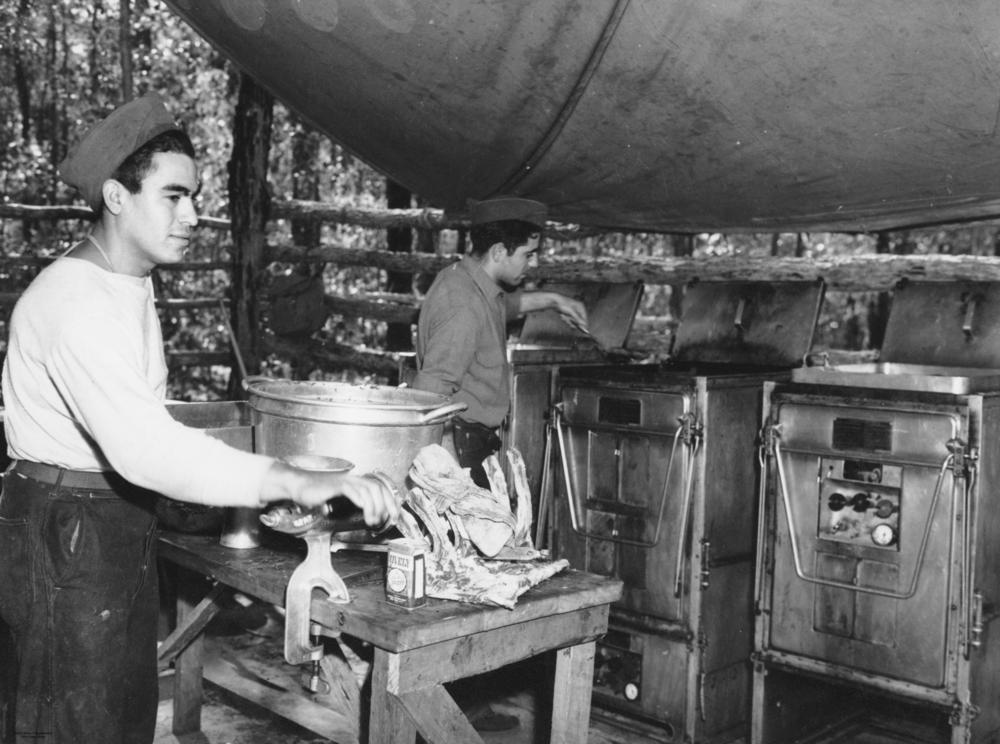B-ration on:
[Wikipedia]
[Google]
[Amazon]
 The B-ration (officially Field Ration, Type B) was a
The B-ration (officially Field Ration, Type B) was a
 The B-ration (officially Field Ration, Type B) was a
The B-ration (officially Field Ration, Type B) was a United States military ration
United States military ration refers to the military rations provided to sustain United States Armed Forces service members, including field rations and garrison rations, and the military nutrition research conducted in relation to military f ...
consisting of packaged and preserved food intended to be prepared in field kitchens by cooks. Its modern successor is the Unitized Group Ration – M (UGR-M), which combines multiple types of rations, including the B-ration, under one unified system.
The B-ration differs from other American alphabetized rations such as the A-ration
The A-ration (officially Field Ration, Type A) is a United States military ration consisting of fresh, refrigerated, or frozen foods. A-rations may be served in dining facilities, prepared in the field using field kitchens, or prepared at a fi ...
, consisting of fresh food; C-ration
The C-ration (officially Field Ration, Type C) was a United States military ration consisting of prepared, canned wet foods. They were intended to be served when fresh or packaged unprepared food was unavailable, and survival rations were insuffic ...
, consisting of prepared wet food when A- and B-rations were not available; D-ration
Military chocolate has been a part of standard United States military rations since the original D-ration bar of 1937. Today, military chocolate is issued to troops as part of basic field rations and sundry packs. Chocolate rations served two ...
, consisting of military chocolate
Chocolate is a food made from roasted and ground cocoa beans that can be a liquid, solid, or paste, either by itself or to flavoring, flavor other foods.
Cocoa beans are the processed seeds of the cacao tree (''Theobroma cacao''); unprocesse ...
; K-ration
The K-ration was a United States military ration consisting of three separately boxed meal units: breakfast, dinner, and supper. It was originally intended as an individually packaged daily ration for issue to airborne troops, tank crews, motorc ...
, consisting of three balanced meals; and emergency rations
Emergency rations are items of food and drink that a person stores and relies on in case of an emergency. Emergency food supplies can be purchased for camping trips or wilderness adventures. These supplies are meant to last for several days. Man ...
, intended for emergencies when other food or rations are unavailable.
Overview
Field rations such as the A-ration, B-ration, and emergency rations consisted of food items issued to troops operating in the field. Like the A-ration, the B-ration required the use of trained cooks and a field kitchen for preparation; however, it consisted entirely of semi-perishable foods and so did not require refrigeration equipment. As of 1982, the B-ration consisted of approximately 100 items which were issued in bulk and packaged in cans, cartons, pouches, and other packing material. An individual ration had agross weight
In science and engineering, the weight of an object is a quantity associated with the gravitational force exerted on the object by other objects in its environment, although there is some variation and debate as to the exact definition.
Some st ...
of 3.639 pounds, measured 0.1173 cubic feet, and could supply approximately 4,000 calorie
The calorie is a unit of energy that originated from the caloric theory of heat. The large calorie, food calorie, dietary calorie, kilocalorie, or kilogram calorie is defined as the amount of heat needed to raise the temperature of one liter o ...
s. B-rations were organized into a ten-day menu cycle which ensured a variety of different meals each day and could be altered as the service needed.Combat Field Feeding System (CFFS). (1986). United States: U.S. Army Quartermaster School. pp. 23–25
The advantage of the B-ration was that it provided balanced nutrition in all climates and individual components could be easily substituted with fresh foods when they became available, a practice highly encouraged to avoid food monotony. However the meals could not be made without trained cooks and required significant investment. Preparing a meal for 100 personnel using B-rations required two to three hours for two cooks to prepare (plus additional personnel to help with serving and clean-up) and on average 75 gallons of potable water.
Unitized Group Ration M
The modern equivalent to the B-ration is the Unitized Ground Ration – M, formerly called the Unitized Ground Ration – B. It is distinct from other forms of UGR, such as theUGR-H&S
The Unitized Group Ration (UGR) is a United States military ration used by the United States Armed Forces and United States Department of Defense, Department of Defense (DoD). It is intended to sustain groups of American Military personnel, serv ...
, in that it consists of dehydrated
In physiology, dehydration is a lack of total body water that disrupts Metabolism, metabolic processes. It occurs when free water loss exceeds intake, often resulting from excessive sweating, health conditions, or inadequate consumption of wate ...
ingredients with an intended recipe in mind, as opposed to precooked or preassembled meals. Unlike the B-ration, the UGR-M is only issued to the United States Marine Corps
The United States Marine Corps (USMC), also referred to as the United States Marines or simply the Marines, is the maritime land force service branch of the United States Department of Defense. It is responsible for conducting expeditionar ...
.
References
{{USmilitaryrations Military food of the United States